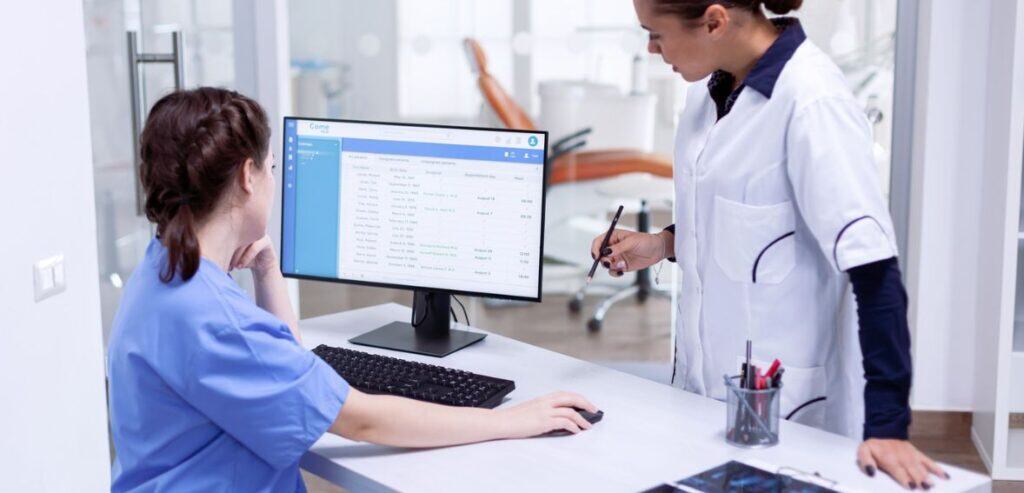
By alphacardprocess September 10, 2025
Quality care will always be the top priority for healthcare providers, but there is an invisible burden of administrative work behind every appointment. EHR systems, while designed to streamline clinical workflows, often become fragmented when not integrated with payment platforms.
Staff members are struggling, and expenses are increased because billing, scheduling, insurance claims, and payment collection frequently take up as much time as providing patient care. Providers are looking for solutions that streamline operations without compromising accuracy or compliance as costs increase and margins contract.
Direct integration of payment systems with electronic health record (EHR) platforms is one of the best strategies. Practices can reduce overhead, increase accuracy, and streamline workflows rather than balancing multiple systems and manually reconciling data. Integration improves the patient experience by lowering billing ambiguity and fostering a more seamless, transparent financial journey, in addition to cost savings.
The Weight of Administrative Overhead

Healthcare operations have long been afflicted by administrative expenses. From big hospital networks to smaller family practices, the percentage of revenue devoted to non-clinical work frequently seems excessively high. Employees invest valuable time in handling insurance adjustments, retyping payment information, reconciling accounts, and entering billing codes.
In addition to time, each of these tasks carries the risk of expensive mistakes. One of the main causes of this inefficiency is the duplication of data between different EHR and payment platforms. Staff must manually transfer information when a payment system doesn’t “talk” to the EHR, which can lead to missed charges, mismatched records, and irate patients.
The labor costs quickly mount up when you multiply this by hundreds or thousands of transactions per month. This doesn’t include the cost of employee turnover, which often stems from staff burnout caused by repetitive, tedious work. An integrated approach reduces these layers of inefficiency by centralizing financial and clinical data into a single platform.
The Hidden Cost of Errors
Billing and record-keeping errors might not seem like much on their own, but over time, they can steal a lot of money. It frequently takes several employees to fix a single incorrect code or misplaced payment record, which raises labor costs and delays reimbursements.
Even worse, when bills seem inconsistent, patients become frustrated by frequent mistakes and may stop trusting their providers. By guaranteeing that data is entered only once and updated automatically across all records, an integrated payment and EHR system reduces these errors.
As a result, there is less duplication, mismatched information is avoided, and staff members can concentrate on meeting patient needs rather than making administrative mistakes. Reducing preventable errors is one of the easiest and most effective ways to control costs for healthcare providers with limited resources.
Payment and Patient Records: Why Separation Hurts

The effects of siloed payment systems are frequently underestimated by healthcare providers. Both employees and patients suffer when billing information is separated from patient records. To put together an extensive financial picture, staff members have to navigate numerous logins, databases, and inconsistent reporting systems.
Conversely, patients frequently receive ambiguous bills, delayed statements, or inaccurate charges—all of which undermine confidence and result in disagreements. Additionally, this division results in inefficiencies for compliance. HIPAA and other regulatory frameworks demand that clinical and financial data be handled carefully.
Maintaining compliance becomes more difficult when these systems stay apart. To make sure nothing is overlooked, practices need to make additional investments in staff training, monitoring, and audits. Providers can avoid many of these issues by directly connecting payments to EHR platforms. Integrated systems automatically align billing codes, visit notes, and payment records, which reduces errors and improves compliance efficiency.
The Economics of Integration
Besides, it is convenient, but integrating payment systems with EHR platforms is also a direct cost-control measure. Administrative labor accounts for a large amount of practices’ operating budgets. Integrated systems lessen the need for human oversight by automating repetitive processes like invoice generation, payment posting, and reconciliation.
This makes it possible for practices to reduce staffing expenses or reallocate staff time to higher-value tasks like care coordination or patient outreach. Moreover, integrated payments lessen the frequency of payment disputes and claim denials, both of which are expensive to settle.
Staff must review claims, resubmit supporting documentation, and frequently wait weeks or months for resolution when a claim is denied. Every claim that is rejected results in additional expenses and lost income.
By ensuring that payment and clinical data flow seamlessly together, practices submit cleaner claims the first time around, reducing denials and speeding reimbursement. This efficiency translates into tangible financial gains, making integration not just a technological upgrade but a business imperative.
Improving Patient Financial Experiences
The patient journey continues into the billing process after they leave the exam room. Regardless of the level of care they received, patients are less likely to return if they receive unclear bills or are taken aback by charges. A more patient-friendly financial experience is produced by integrated payment and EHR systems. In one location, patients can view their insurance coverage, treatment notes, and payment responsibilities.
This openness decreases the possibility of conflict and fosters trust. Additionally, it facilitates timely bill payment for patients. Practices can offer secure and flexible payment methods for patients—such as digital portals and installment options—directly linked to their EHR systems, ensuring seamless, patient-centered billing.
This results in quicker payments, fewer past-due accounts, and lower collection expenses for providers. In an industry where patient satisfaction increasingly influences reimbursement and reputation, offering a smooth billing experience is as critical as delivering excellent medical care.
Integration as a Patient Retention Tool
Although internal efficiency is frequently the main focus of integration, patient loyalty is equally affected. When a provider offers stress-free, accurate, and transparent billing, patients are more likely to use them again. Practices provide patients with a single platform to view treatment information, insurance coverage, and payment history by integrating payments with EHRs.
Patients feel valued and informed as a result of this transparency, which also lessens uncertainty and anxiety. These satisfying encounters eventually build trust and enduring loyalty, which lowers expensive patient attrition.
Utilizing integration to improve patient relationships becomes not only a matter of operational efficiency but also a potent retention strategy with Immediate financial benefits because it is far more expensive to acquire new patients than to retain current ones.
Time Savings and Workforce Impact

In any industry, healthcare personnel are among the most overworked. The amount of administrative work involved in scheduling, billing, documentation, and patient intake can be too much to handle. By doing away with repetitive tasks, integrated systems greatly reduce this burden.
For example, the system automatically posts the transaction, updates the patient’s balance in the EHR, and, if necessary, reconciles it with insurance claims whenever a payment is made. Cost savings are a direct result of the time saved. Staff members can concentrate on enhancing patient engagement or care coordination rather than wasting hours reentering data or fixing mistakes.
Burnout rates are also decreased by the lighter workload, which increases employee retention and lowers recruiting and training expenses. When staff feel that their work is efficient and meaningful rather than bogged down by clerical redundancies, morale improves, and the overall quality of care delivery rises.
The Role of Compliance and Security

Data security and compliance are non-negotiable in the healthcare industry. EHRs and payment systems both deal with private data that needs to be strictly regulated. Because data must be moved between platforms and stored in various locations, the number of possible vulnerabilities rises when systems function independently.
Every transfer is a possible point of failure, whether due to malicious attacks, technical difficulties, or human error. By centralizing sensitive data in a secure setting, integrated platforms lower these risks. Errors and breaches are less likely when there are fewer data transfers.
Furthermore, sophisticated encryption and monitoring tools that assist practices in staying ahead of changing security threats are frequently included in integrated systems. From the standpoint of compliance, keeping accurate and consistent records on a single platform streamlines audits and lowers the administrative expenses related to regulatory reporting.
Financial Forecasting and Business Insights
In addition to daily cost savings, integrated systems offer a competitive edge in financial forecasting. Providers can better understand revenue trends, patient payment behavior, and service demand when payment and clinical data are integrated. Better choices regarding pricing, service expansion, and staffing can be made with the help of this data.
Through integrated reporting, for example, a practice might discover that some services result in more payment delays than others. This realization may lead to changes in patient communication tactics or billing regulations.
In a similar vein, practices can improve cash flow management by identifying peak payment cycles. Integrated systems reduce administrative expenses and promote long-term financial stability by converting unprocessed payment data into useful business intelligence.
The Role of Real-Time Data
Clinical and financial healthcare decisions frequently depend on timely data. A practice’s perception of its financial health may be deformed by reporting delays and out-of-date data when payment and EHR systems function independently. By providing real-time data on patient balances, insurance reimbursements, and overall cash flow, integrated platforms address this issue.
With access to up-to-date data, providers can decide on staffing, resource allocation, and even expansion more quickly and intelligently. Additionally, real-time reporting enables employees to take proactive measures to resolve payment concerns rather than waiting weeks for disparities to be discovered.
The ability to act on real-time data gives providers a competitive edge and helps them control administrative expenses in a competitive healthcare environment where agility is crucial.
Implementation Challenges and Solutions
Of course, there are challenges to overcome when switching to an integrated payment and EHR system. Practices frequently need to migrate massive amounts of data, train employees, and invest in new technology. Some providers may be hesitant due to the time-consuming and initially expensive nature of these procedures.
However, the short-term disruption is nearly always outweighed by the long-term savings and efficiency gains. Careful planning is necessary for successful implementation. To guarantee that integration is customized to their workflows, practices should collaborate closely with vendors.
Because an integrated system is only as good as its users, staff training is equally important. Most practices find that the transition goes more smoothly than expected if they have proper support and implement the change gradually. When put into practice, the advantages are immediately apparent in the form of less administrative work, higher patient satisfaction, and more robust financial performance.
Looking Ahead: The Future of Healthcare Administration
EHR and payment system integration is only one phase in the larger trend of healthcare administration becoming more digital. We may anticipate that these systems will develop even more as machine learning and artificial intelligence advance, automating not only transactions but also predictive analytics and customized patient billing plans.
The ultimate objective is a healthcare setting in which providers are not burdened by administrative expenses, freeing up more funds for patient care. For practices looking to reduce expenses, boost productivity, and improve patient relations in the interim, integrated systems provide a clear route forward. They are among the most beneficial investments a provider can make because they transform the administrative load into a chance for expansion.
Long-Term Scalability of Integrated Systems
One often overlooked benefit of integrated payment and EHR systems is scalability. As a practice grows, administrative tasks multiply—more patients mean more claims, more payments, and more potential errors. Without integration, scaling up often requires hiring additional staff, which further increases administrative costs.
Integrated systems, however, grow with the practice. They can handle larger transaction volumes without adding proportional labor expenses, ensuring efficiency even as patient numbers rise. This makes integration a future-proof investment: rather than repeatedly hiring, retraining, or restructuring, practices can rely on technology to absorb growth.
For providers looking to expand services, open new locations, or adapt to value-based care models, scalable integration ensures sustainability while keeping costs manageable in the long run.
Conclusion
Reducing administrative expenses involves more than just reducing spending; it also involves creating a more effective, open, and patient-centered healthcare system. EHR and payment systems that are integrated offer a potent means of striking this balance. They provide advantages that go well beyond financial savings by optimizing processes, cutting down on errors, improving compliance, and enhancing the patient financial journey.
Integration is more than just a technological convenience for healthcare providers who are burdened with administrative overhead; it is a strategic necessity. The ability to lower expenses while enhancing care delivery is revolutionary in a field where every dollar and every second of employee time counts. Providers can maintain their organizations’ financial viability while adhering to their mission of providing outstanding care by adopting integrated solutions.